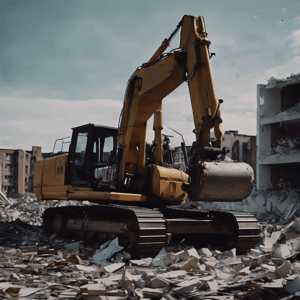Demolition health and safety RAMs pack. BEST OFFER

All the RAMs a demolition company needs in a straightforward document.
We're excited to offer you a comprehensive package that covers all the necessary documents for residential rip-outs and demolition. This package compiles nine papers we've put together based on our extensive professional experience and thorough analysis of our customers' download trends. By purchasing this package, you'll have the opportunity to showcase the "Health & Safety Gold Standard Award" on your website, which will inform your clients, customers, and contractors that your health and safety package and RAMS (Risk Assessment and Method Statement) are current and up to date.
Table of contents for demolition package:
Risk assessments for:
- 01) Rip out and demolition
- 02) Risk awareness for areas where asbestos could potentially be discovered
Method statements for:
- 03) Removing suspended ceiling
- 04) Removing stud walls, doors and windows
- 05) Removal of floor coverings
- 06) Breaking out a concrete floor
- 07) Removing kitchens and bathrooms
COSHH assessments for:
- 08) Dust
- 09) PPE and site-specific rules
This package, created by trained health and safety professionals, can improve your chances of winning tenders. It includes a collection of documents that can be purchased individually, but buying the package will save you over £35. All records are available in docx format, so you can easily add your company details and logo using Word or your preferred processor.
This package is:
- Recognised by local authorities.
- Recognised by principal contractors.
- Suitable for CDM sites.
- Approved by H&S managers.
Ensuring workplace health and safety (H&S) is crucial to protect everyone, including the general public, permanent employees, temps, casual workers, self-employed individuals, and even delivery personnel. In today's world, businesses are responsible for the safety and well-being of others if their premises or activities cause harm to anyone.
The construction industry is considered to be a high-risk industry due to the high number of injuries and fatalities reported annually. Despite the current health and safety measures in place, there are still over 50,000 injuries and 30 deaths each year. Better health and safety management is necessary to minimise the accident rate. As a result, small companies are also required to conduct risk assessments, method statements, and COSHH assessments.
Falls from height account for approximately half of all fatalities, and a breakdown of the 50,000 non-fatal injuries is as follows:
- Slips, trips and falls on the same level account for 25%
- Falls from height account for 18%
- Manual handling injuries make up 20%
- Being struck by a moving or flying object is 10%
It’s important to remember that the 50,000 reported injuries are much lower than the accident rate because many people can have a slip or fall without injury, so they don’t report it.
Training can often be as simple as telling someone something so that both people can follow the same rules. It could also be a toolbox talk, a training meeting, an online course, a training video or a site demonstration.
There are many ways to communicate messages, and if safer working practices have been introduced, the people carrying out the work should be trained or informed before they begin the task.
Imagine you were contracted to paint 500 houses blue, and all the painters were provided with litres of blue paint to complete the job. Suddenly, the architect changes the colour to white. In such a scenario, it would be essential to notify all the painters as soon as possible to avoid confusion and ensure they have the right paint for the job. Similarly, if new control measures or different working practices are introduced, it is crucial to communicate the changes promptly to those involved. Failure to do so could result in accidents, injuries, and liability for the employer if a new hazard has been identified but the workers are unaware and suffer an accident. Therefore, it is essential to prioritise communication and ensure that everyone involved is on the same page to avoid any unfortunate incidents.
As a business owner, you may have experienced the feeling that health and safety requirements are never-ending and overwhelming. It can be frustrating to submit all the necessary risk assessments only to be informed that you need to have additional policies in place before moving forward with a project. However, it's essential to understand that some health and safety documents are legally required, while others are requested by the organisations you work with.
You are legally bound to have several documents, such as Risk Assessments and COSHH assessments. If your business employs more than five people, you must also have a Company Health and Safety Policy. Although Method Statements are not legally required, they are usually necessary for most principal contractors. Other documents, such as a lone worker policy, may be requested by organisations that have an approved supplier list.
Our package includes several important health and safety documents, including Risk Assessments, Method Statements, and COSHH Assessments. However, we do not include a company health and safety policy as this is a standalone document outlining your company's health and safety approach. It's not specific to a particular job or project that you may be undertaking.
GET THIS DOCUMENT
£35.00+VAT
- Available in Word™
- Fully customisable
- Add your Company Logo
- UK & EU Compliant

 CART
CART